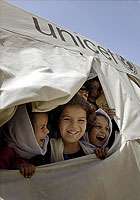Tens of thousands of schoolchildren in Kabul are set to benefit from a $24 million donation from Japan, under an agreement signed today with the United Nations Children's Fund (UNICEF) to construct around 1,000 classrooms.
(Photo © UNICEF 2008/Rich: A UNICEF tent on the grounds of Aino Girls School in Kandahar helps with the overwhelming demand for education)
Also in Kabul today, the UN Mine Action Program for Afghanistan (MAPA) announced that the city's electricity supply has improved as a result of its mine-clearing operation in the north of the country.
Although Afghanistan has made progress towards achieving its target of primary education for all by 2020, around 40 percent of school-age children still do not attend school, of which 65 percent are girls.
"Parents are demanding education for their children as evidenced by the over 6 million children who have been enrolled in schools in 2008," said UNICEF Representative for Afghanistan, Catherine Mbengue.
"Government and its partners including UNICEF are doing their utmost to respond to this demand so that parents of this country see their children enrolled and complete their education cycle," added Ms. Mbengue.
The new classrooms built thanks to the multi-million dollar fund will allow some 80,000 children to attend classes, helping meet the objectives of the Five-year National Education Strategic Plan, which include the creation of safe learning environments, especially for girls, improving the quality of education and developing a healthy relationship between schools and their communities.
Currently there are 35 schools in Kabul without an adequate building, and 25 schools operate on a four-shifts-a-day system because of the shortage of learning space, resulting in very little time for any effective teaching and learning to take place.
Over the last eight years, Japan has contributed $89 million supporting the work of UNICEF in Afghanistan most notably in the fields of education and health.
The mine-clearing operation, covering a stretch of land from Pul-i-Kumri to Hairatan previously infested with landmines, is the route used for the power lines supplying electricity to Kabul.
"This is a classic example of how demining is the crucial first step in development. If this route had not been cleared, we would not now be celebrating our improved power supply which will enable development in our country," said Mine Action Coordination Centre of Afghanistan Programme Director Haider Reza.
In 2008 alone, MAPA destroyed more then 84,000 anti-personnel mines, 900 anti-tank mines and 2.5 million explosive remnants of war.
_____________
Also read the WS reports from July 2008 Afghanistan Making Significant Progress in Mine Clearance;
from June, 2007, Land in Afghanistan Donated to Mine Victims;
and August, 2006, One Man's Mission to Fight Terrorism and Build Peace One School at a Time










Be the first to comment